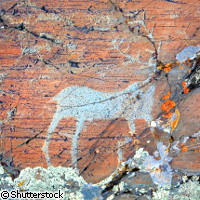Archaeologists find clues to the appearance of modern human
New findings from an excavation site in Spain are generating heated debate among palaeontologists and archaeologists about precisely when the Neanderthals disappeared and were replaced by the first anatomically modern human beings. The research, carried out by a team from the Centre for Prehistoric Archaeological Heritage Studies at the Universitat Autònoma de Barcelona, and published in the Journal of Human Evolution, pinpoints the transition to between 34,000 and 32,000 years ago, and supports the hypothesis that that the two species did not interact or coexist. The archaeologists carried out their research at a site called Cova Gran in the south-eastern Pyrenees in Catalonia, Spain, that was inhabited by Neanderthals and modern humans at different times in the past. Covering a total surface area of 2,500 square metres, Cova Gran is a rarity for archaeologists; sites of this 'transitionary' type are crucial to palaeontologists and archaeologists as they offer them a chance to trace the development of the human species. The research team excavated a large area of Cova Gran, enabling them to reconstruct the way that previous inhabitants lived. Many exceptionally well preserved materials including tools were discovered from both the Middle Palaeolithic (300,000 to 30,000 years ago) and Upper Palaeolithic (40,000 to 10,000 years ago periods, allowing the different species involved to be identified from the ways in which the tools were made. Differences in the construction of the tools imply that they were made by different species. The results from Cova Gran, which were obtained by Carbon 14 (C14) dating, show that the area was inhabited by different types of human, including Neanderthals and 'modern' humans, at different periods of prehistory. Their lifestyles were similar in many ways: they hunted, gathered, made tools and used fire. But they employed very different techniques and materials in their day-to-day lives. The C14 dating process showed that remains at the site are between 34,000 and 32,000 years old, the time when it is believed that Neanderthals became extinct and modern humans took their place. This backs up evidence from excavations in other European sites where similar results have been noted, furthering evidence that the two species did not interact although they may have inhabited the same area 40,000 to 30,000 years ago, which is generally referred to as the Middle/Upper Palaeolithic transition period. Other finds at Cova Gran include perforated sea-snail shells. These ornaments signify the existence of cognitive capacities for which there is, as yet, no evidence during the Middle Palaeolithic period. As well as offering us clues to their social structures and identity, the existence of the perforated shells indicates that Homo sapiens may have travelled widely and had social networks in which objects of this type would have circulated.
Countries
Spain



